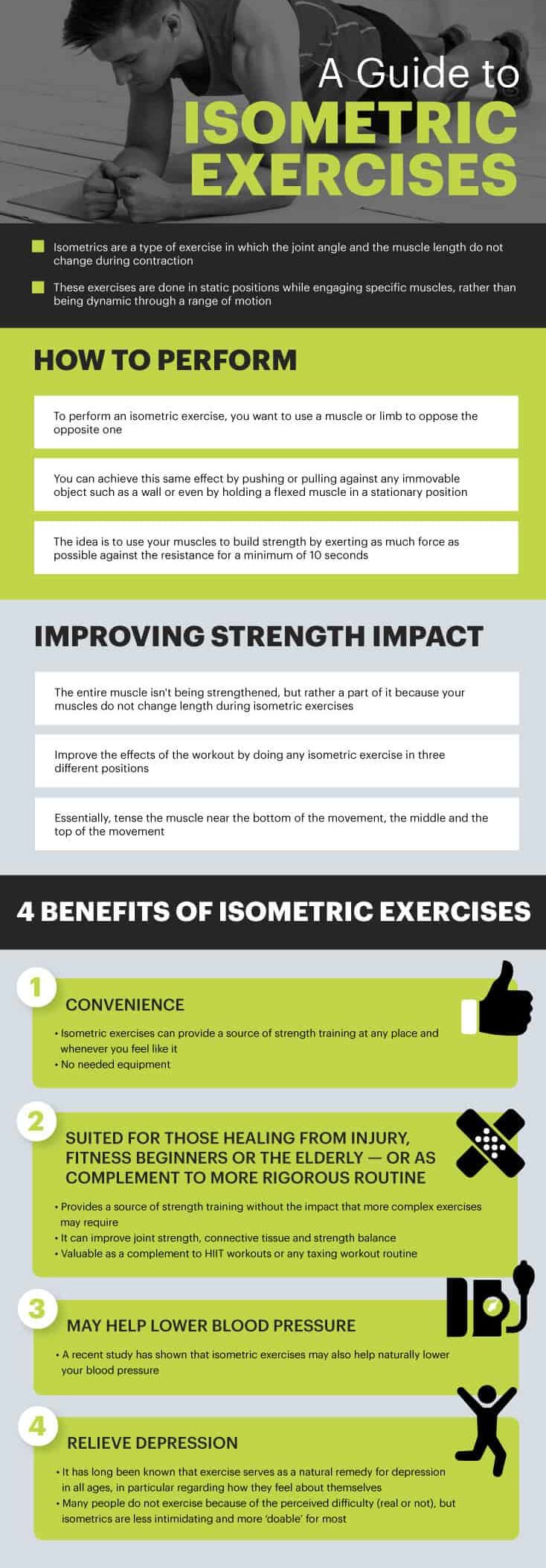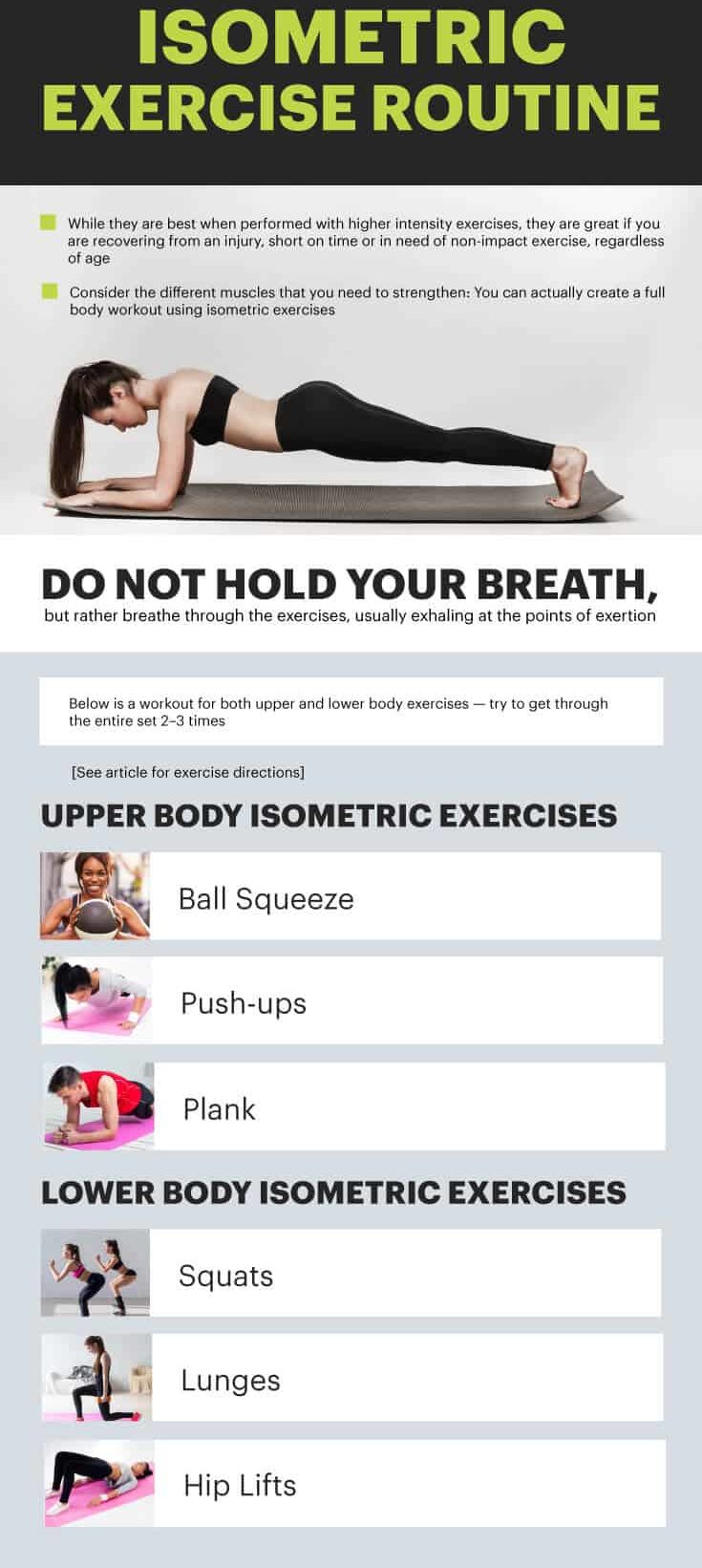Imagine if you could do effective exercises in only 10 seconds, anywhere, anytime … without any equipment. This is absolutely possible with isometric exercises, which are perfect for anyone who wants to tone muscles and gain strength in a way that doesn’t require impact or full range of motion.
Isometric training is also valuable as a complement to high-intensity interval training (HIIT) workouts or any taxing workout routine, as it can improve joint strength, connective tissue and strength balance. Plus, these exercises can be done anywhere.
What Are Isometric Exercises?
A common method of muscular strength training, isometric exercise or isometrics are a type of exercise in which the joint angle and the muscle length do not change during contraction. In other words, these exercises are done in static positions while engaging specific muscles, rather than dynamic through a range of motion.
Unlike standard strength training, isometrics allow you the freedom to practice them anywhere without needing weights or special equipment.
The U.S. National Library of Medicine defines isometric exercises as static exercise that involves sustained contraction of skeletal muscles against fixed resistance and does not involve movement of the joints or axial skeleton. Classic examples of these types of exercises include hand grip motions and certain weightlifting moves. Also, movements in many competitive sports and daily activities involve isometric exercise.
Ad
Another example of isometric exercise that is very beneficial is power yoga. In the book “Yoga Exercises for Beginners: Yoga Mind, Body & Spirit, Increase Your Energy Levels, Feel Great and Lose Weight” by Anton Devlin, the author writes that isometric exercises are some of the best ways to strengthen the core.

Isometric, stemming from the words “same” and “length,” simply translate to holding one position without moving. Power yoga uses isometric exercises along with numerous other postures that are designed to strengthen the core and back.
Because flexibility, balance and power stem from your core, it’s imperative to train this area of the body. While most yoga classes encompass isometric exercises, the power yoga style focuses more on core work, and the temperature in the room is typically warmer to help keep the muscles warm and release additional toxins from the body.
The Journal of Sports Sciences published an abstract regarding studies of the differences between isometric and dynamic strength training. It states that strength training with isometric contractions produces large but highly angle-specific adaptations.
The study compared the strength gains produced by isometric training at four joint angles with conventional dynamic training. Thirty-three recreationally active healthy males aged 18–30 years completed nine weeks of strength training of the quadriceps muscle group three times per week. One leg performed isometric training at each of four joint angles, and the other leg performed conventional dynamic training by lifting and lowering.
about:blank
Both legs trained at similar relative loads for the same duration.
The quadriceps strength of each leg was measured isometrically (at four angles) and isokinetically (at three velocities) before and after training. After nine weeks of training, the increase in isokinetic strength was similar in both legs — however, the isometric strength increases were significantly greater for the isometrically trained leg.
The study shows that isometric exercises are very beneficial, especially for those that prefer a no-impact workout.
Benefits
The National Institutes of Health reminds us that moving more and sitting less can reduce the risk of many serious conditions, including heart disease, diabetes, osteoporosis and certain kinds of cancer. Some studies suggest that physical activity can have mental benefits as well.
1. Convenient style of training at any place and at almost any time
Isometric exercises can provide a source of strength training at any place and whenever you feel like it. While there is some equipment that you may find useful for isometric exercises at the gym, you can perform these exercises without any equipment at all, making it very convenient while helping you maintain your fitness goals.
2. May be helpful to someone who is healing from an injury
Isometric exercises provide a source of strength training without the impact that more complex exercises may require. For example, if you have a shoulder injury, a physical therapist may recommend some isometric exercises that stabilize the shoulder and maintain strength in that area so the recovery is faster.
In fact, isometric exercises have been shown to help with recovery from hamstring injuries, a common sports and/or workout issue.
3. May help lower blood pressure
Isometric exercises may also help naturally lower your blood pressure since exercising at higher intensities can cause a dramatic increase in your blood pressure, specifically during the activity.
Regardless, it is important to check with your doctor before beginning isometric exercises if you have high blood pressure or any heart problems.
A study conducted by the Division of Cardiology at University Health Network in Toronto also suggested that isometric exercise training in young and old participants may produce reductions in blood pressure. In this case, isometric exercise training protocols typically consisted of four sets of two-minute hand-grip or leg contractions sustained at 20 percent to 50 percent of maximal voluntary contraction, with each set separated by a rest period of one to four minutes.
Ad
Training was usually completed three to five times per week for four to 10 weeks. Improvements in the regulation of heart rate and blood pressure were reported.
Some key things to remember: never hold your breath or strain during any weight training exercise, as this may cause a dangerous rise in blood pressure.
4. Help relieve depression
It has long been known that exercise serves as a potential natural remedy for depression in all ages, in particular regarding how people feel about themselves.
As noted in the book “The Principles and Practice of Resistance Training,” one of the authors compared the self-esteem of runners, weight trainers and non-exercise groups using the Tennessee Self-Concept Scale. A common pattern did not differ statistically between the running and weight training groups, but both exercise groups reported improved self-esteem relative to the non-exercising control group.
How to Perform Isometric Exercises
To perform an isometric exercise, you want to use a muscle or limb to oppose the opposite one. You can achieve this same effect by pushing or pulling against any immovable object, such as a wall, holding a firm medium to large ball with your hands and pressing inward toward the ball, or even by holding a flexed muscle in a stationary position.
The idea is to use your muscles to build strength by exerting as much force as possible against the resistance for a minimum of 10 seconds.
The most effective way to use isometrics is to incorporate it into a larger strength-training program, such as our burst training or a kettlebell workout. While isometric exercise offers great benefits, it is important to understand the limitations. Each isometric contraction only increases muscular strength in the exact position you are engaging versus a large muscle group.
For this reason, you need to perform various isometric exercises to help strengthen various muscles, rather than using a compound exercise that can work multiple muscles — think the squat exercise vs. a static squat. This is why it is best to think about isometrics as a complement to your weight training or burst training rather than a replacement.
Let’s look at it another way: The entire muscle isn’t strengthened, rather just a part of it. This is because your muscles do not change length during isometric exercises in the same way they do when you lift a weight.
You can improve the effects of the workout by doing any isometric exercise in three different positions. Essentially, tense the muscle near the bottom, middle and top of the movement.
A great example is with the biceps. When you do bicep curls, the bottom means the arm fully extended, the middle means the elbow at an angle near 90 degrees and the top means your hand near your shoulder. Hold each for at least 10 seconds.
You can do this without weights simply by tensing the muscle at each point.
Isometric Exercise Routine
Isometric exercises are for anyone. While they are best when performed with higher-intensity exercises, they are great if you are recovering from an injury, short on time or in need of non-impact exercise, regardless of age. The elderly may also benefit from isometric exercises due to their non-impact style as well as the need to focus on the specific muscle you are working.
It is important to determine a routine that will be effective and do your best to be consistent by performing the routine, and variations of it, at least two to three times per week.
Consider the different muscles that you need to strengthen. You can actually create a full-body workout using isometric exercises.
It is important, like with all exercise routines, that you do not hold your breath, but rather breathe through the exercises, usually exhaling at the points of exertion.
Below is a great workout that includes both upper- and lower-body exercises. Try to get through the entire set two to three times.
Upper-Body Isometric Exercises
Ball Squeeze: Using a medicine ball, hold it in front of you using both hands. Squeeze the ball as hard as you can, holding the squeeze for 10–30 seconds.
Release, and repeat five to 10 times.
Push-ups: Starting in the push-up position with arms fully extended, lower yourself to about half way to the floor. Hold this position for 10–20 seconds, remembering to breathe. Repeat two to three times.
If needed, start on your knees (keep a straight line from your knees to the top of your head), and over time you will gain more strength and be able to do the push-ups on your toes. (Also try a push-up in a TRX workout.)
Plank: Start with your arms bent at 90 degrees, and rest on your elbows directly below your shoulders. Hold the plank position for 10–30 seconds while engaging your core, hips and butt. Repeat the plank exercise five to 10 times.
Again, if needed, start on your knees, and over time you will gain more strength and be able to do the planks on your toes.

Lower-Body Isometric Exercises
Squats: Place your back against a wall (or no wall), and lower yourself until your quadriceps are parallel to the floor. Extend your arms in front of you. Keep your upper body upright. (Do not lean over.)
The easiest way to think of the isometric squat is to sit in an imaginary chair, placing your weight on your heels. Hold for 10–20 seconds, engaging your abs, quads and butt. Release.
Repeat 10–20 times.
Lunges: Stand with legs staggered, right foot in front and spread far enough apart that you can lower yourself near the ground. Left knee is almost touching the ground, and calf is parallel to the ground. Right quadricep is parallel to the ground, and your knee should not extend past your foot.
If you need help with balance, place a sturdy chair next to you. Start in the standing staggered position, and lower yourself to the ground with hips slightly tucked, holding the position for 10–20 seconds while engaging the butt and and right upper leg.
Repeat 10–20 times on that side, and then repeat the same number of repetitions on the other side.
Hip Lifts: Lie face up on the floor. Knees are up, and feet are on the ground hip distance apart with your heels near your butt. Push your hips into the air, and squeeze your butt as hard as you can while engaging your abs for 10–30 seconds.
Want a little more resistance? Hold a weight on your abdominal and hip area. Release, and repeat 10–20 times.
Potential Risks
You should always consult your physician before starting any exercise program. While isometric exercise is beneficial for blood pressure overall, it can cause the blood pressure to increase during the workout because when a muscle contracts, blood is forced out of the muscle tissue and into the bloodstream.
Also, never hold your breath during exercise, as this can cause your blood pressure to increase.





